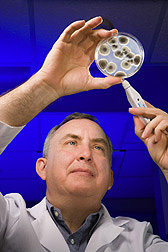This page has been archived and is being provided for reference purposes only. The page is no longer being updated, and therefore, links on the page may be invalid.
|
Read the magazine story to find out more. |
|
|
|
|
Antifungal Pepper Compound Has Potential in Agriculture and Medicine
By Rosalie Marion BlissJuly 9, 2009
Dried, ground cayenne peppers have been spicing up cuisine for thousands of years. Now, Agricultural Research Service (ARS) scientists and colleagues have found that a patented antifungal plant compound in cayenne, called CAY-1, holds promise for dual use as an antifungal in both agriculture and medicine.
The substance is believed to work by attaching to fungal membranes, where it causes cell components to leak, eventually killing the cell. CAY-1 may also enter fungal cells, and adversely affect certain signaling pathways that, in turn, damage the mitochondria—the powerhouses for several cellular processes—in cells.
Anthony De Lucca, a microbiologist with the Food and Feed Safety Research Unit at the ARS Southern Regional Research Center (SRRC) in New Orleans, La., led a study in which he and colleagues isolated 10 fungi—either primary or secondary grape pathogens—from diseased grapes grown in a hot, humid environment. Primary pathogens directly cause infection, whereas secondary pathogens infect after the hosts's defenses have been compromised by stress, injury, or other infection.
They tested CAY-1 against these fungi in the laboratory. CAY-1 was lethal during the early spore germination cycle of seven of the fungi, but was inactive against dormant spores. While CAY-1 was lethal to the grape pathogens, additional research is required to indicate if, and how, the compound could be used safely on grapes. This work was published in the American Journal of Enology and Viticulture.
The SRRC researchers also have collaborated with physician Thomas Walsh and others at the National Institutes of Health (NIH) in Bethesda, Md., to study CAY-1 activity against Microsporum canis and Trichophyton rubrum, which are skin fungal pathogens that infect immune-compromised individuals. The study showed that CAY-1 is active in the laboratory against these skin pathogens. That study was published in the journal Medical Mycology.
Read more about this research in the July 2009 issue of Agricultural Research magazine.
ARS is the principal intramural scientific research agency of the U.S. Department of Agriculture.

